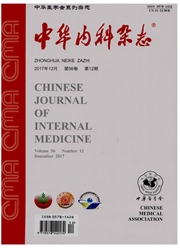

 中文摘要:
中文摘要:
目的观察微炎症状态下低密度脂蛋白受体(LDLr)途径在终末期肾病(ESRD)患者泡沫细胞形成及动脉粥样硬化(AS)进展中的作用,并初步探讨雷帕霉素靶蛋白(mTOR)通路激活在炎症致LDLr途径失调中的作用机制。方法根据血清C反应蛋白(CRP)水平将30例ESRD患者分为对照组(16例)和炎症组(14例),取动一静脉内瘘手术时部分切除的桡动脉组织,观察脂质沉积情况;免疫组化检测肿瘤坏死因子α(TNFα)及单核细胞趋化因子-1(MCP-1),同时检测mTOR、LDLr及其基因转录调节相关因子的表达,如固醇调节元件结合蛋白-2(SREBP-2)及SREBP裂解激活蛋白(SCAP);免疫荧光染色检测SCAP与高尔基体的共转位情况。结果两组患者在病因、年龄、体重、血红蛋白、总蛋白、白蛋白、血糖、血脂谱等指标之间差异无统计学意义(P值均〉0.05);炎症组患者桡动脉TNFα及MCP—1表达增加,并伴随大量泡沫细胞形成和脂质沉积;炎症组患者桡动脉LDLr表达及SCAP由内质网膜向高尔基体的转位显著增加(P〈0.05)。进一步分析显示,炎症组LDLr表达增加与mTOR表达上调具有较高的相关性(r=0.733,P〈0.05);且炎症组mTOR与SREBP-2共表达明显高于对照组(P〈0.05)。结论微炎症状态下,ESRD患者AS进展加速,其机制可能与炎症诱导mTOR通路激活,破坏LDLr负反馈调节,导致泡沫细胞形成增加有关。
 英文摘要:
英文摘要:
Objective To investigate whether inflammation exacerbates lipid accumulation in the radial arteries of patients with end-stage renal disease (ESRD) and to explore its underlying mechanisms. Methods Thirty ESRD patients receiving arteriovenostomy were included. The patients were divided by the plasma level of C-reactive protein into control group (n = 16) and inflamed group (n = 14). Foam cell formation and lipid droplet accumulation were checked by HE staining and Oil red O staining. Tissue inflammation and intracellular cholesterol trafficking correlated proteins were examined by immunohistochemistry or immunofluorescent staining. Results There were no differences in primary diseases, age, body weight, hemoglobin, total protein, albumin, glucose, lipid profile between the two groups (all P values 〉 0. 05 ). The expressions of tumor necrosis factor α(TNFα) and monocyte chemotactic protein-1 ( MCP-1 ) of the radial artery were increased in the inflamed group. There was significant lipid accumulation in the radial arteries of inflamed group compared to the control group, which was correlated with the increased protein expressions of low density lipoprotein receptor (LDLr) , sterol regulatory dement binding protein-2 (SREBP-2), and SREBP cleavage-activating protein (SCAP). Confocal microscopy observation showed that inflammation enhanced the translocation of SCAP escorting SREBP-2 from endoplasmic reticulum to Golgi, thereby activating LDLr gene transcription. Further analysis showed that dysregulation of LDLr pathway induced by inflammation was associated with increased protein expression of roTOR ( r = 0. 733, P 〈 0. 05 ) , especially with the enhanced co-expression of roTOR and SREBP-2 ( P 〈 0. 05 ). Conclusion Inflammation accelerates the progression of foam cell formation in ESRD patients via dysregulation of LDLr pathway, which might be partly through the activation of mTOR pathway.
 同期刊论文项目
同期刊论文项目
 同项目期刊论文
同项目期刊论文
 Analysis of the spectrum and antibiotic resistance of uropathogens in vitro: Results based on a retr
Analysis of the spectrum and antibiotic resistance of uropathogens in vitro: Results based on a retr Activation of mTORC1 disrupted LDL receptor pathway: A potential new mechanism for the progression o
Activation of mTORC1 disrupted LDL receptor pathway: A potential new mechanism for the progression o Activation of mTOR contributes to foam cell formation in the radial arteries of patients with end-st
Activation of mTOR contributes to foam cell formation in the radial arteries of patients with end-st Dysregulation of low-density lipoprotein receptor contributes to podocyte injuries in diabetic nephr
Dysregulation of low-density lipoprotein receptor contributes to podocyte injuries in diabetic nephr Activation of renin-angiotensin system is involved in dyslipidemia-mediated renal injuries in apolip
Activation of renin-angiotensin system is involved in dyslipidemia-mediated renal injuries in apolip Increased mTORC1 activity contributes to atherosclerosis in apolipoprotein E knockout mice and in va
Increased mTORC1 activity contributes to atherosclerosis in apolipoprotein E knockout mice and in va Inflammatory Stress Exacerbates the Progression of Cardiac Fibrosis in High-Fat-Fed Apolipoprotein E
Inflammatory Stress Exacerbates the Progression of Cardiac Fibrosis in High-Fat-Fed Apolipoprotein E 期刊信息
期刊信息
